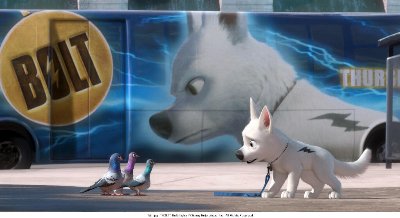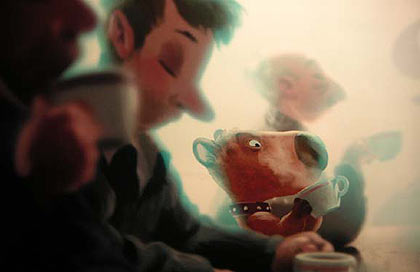Rhett Wickham: The Art of Bolt Review
Page 2 of 3
The book tries much too hard to make Disney seem humble, standing in the shadow of a Pixar so wise that producer Clark Spencer is characterized as reflecting wistfully on how great it would be to �download� everything that Pixar knows about CG animation that Disney doesn�t. The parochial whack of the ruler on the knuckles of those churlish Disney upstarts is a constant sting felt throughout this text.
What�s missing from this carefully crafted history of the making of Disney�s latest CG offering is any link to this film�s origins. �American Dog� gets barely a dozen mentions. The text makes little reference to a time before the enormously talented Mr. Howard and his equally talented co-director Chris Williams came on board the project. Chris Sanders� - there, I said it � impact on the feature is hardly minor, but the book would have us believe that some generic artists were to blame for Ed Catmull and John Lasseter having decided in early 2006 to �call a halt to the production�, citing �story problems�. Indeed. Of all the �story problems� Disney has encountered since Walt cut the bed building sequence and the soup eating scenes from �Snow White and the Seven Dwarfs�, none has been as whitewashed as the 150 words that lead off page ten of this book, and effectively make anything that took place on this film prior to January of 2006 positively antediluvian.
This would be easy to ignore, since this book, like all other �art of� books, is essentially a visual banquet and the real reason most readers will pick up the book is to see how the film evolved. Even in this the book fails to be an authentic record of development. Sure, we see works titled �exploratory painting� and �early development painting�, but just how early? Save an illustration on the fly leaf and one other giddy glance on page 25, in which Byron Howard manages to capture an outrageously eager Bolt in a �Character Exploration�, the thumbprint of Chris Sanders (that�s two for those of your waiting for a puff of smoke and a sudden appearance by��him�) is as conspicuously absent from Cotta Vas� written and visual narrative as George Bush was during John McCain�s presidential campaign. It�s as if he never existed.

Click here for a much larger version of this picture
The author and the editors could be forgiven for obeying the rules of revisionist history, bowing to the obvious corporate intent, were it not for the book�s final chapter titled �The Trust.� Here are paragraphs of insincere observations that would put Marc Anthony to shame, as we are expected to look the other way while blade after blade is thrust into the ghost of their departed colleague, including comments about how talent is valued, and the previous feeling of �film-making by committee� has now been replaced by a respect for �vision.� Really? Exactly whose vision?
Most Disneyphiles know by now that Lasseter summarily fired the Lilo creator from what was then �American Dog�, a project Chris Sanders (�.oops!�.nothing? Hmmmm Well, anyway) a project Mr. Sanders imagined and which he had been guiding for several years. The book gives us absolutely no idea of what is left of his influence on the film, but the signature bottom-heavy limbs and Macy�s balloon shapes that fill �Lilo and Stitch� and the artist�s stunning on-line comic strip Kiskaloo are pretty much gone from the designs that appear in the book. They have been replaced by another look, entirely, and while that is sad, at least for those who admire the distinct style of the first person ever hired into Disney�s visual development division, and who so capably anchored the story of Mulan.

Visual Development from �American Dog�, copyright Disney. All Rights Reserved.
What replaces it is the capable graphic stylings of some very fine folks, nonetheless. His snout pulled into a finer point, and his ears cut like Isosceles triangles, Bolt under Howard and Williams maintains a puppy-appeal that will have white shepherds vanishing from animal shelters coast to coast. He owes more than a little to Thunder from 1961�s �101 Dalmatians�, but the Jim Kim facial studies that sit just under that Sandersesque rendering of Howard�s on page 25 seem more fitting to an out of touch TV hound who takes himself just a little too seriously for his own good. This is a much more distinctly �Disney� dog than what we saw in the images of Sanders� seemingly existential canine, sipping coffee at a roadside diner back in the dark ages, before the Pixar merger.
